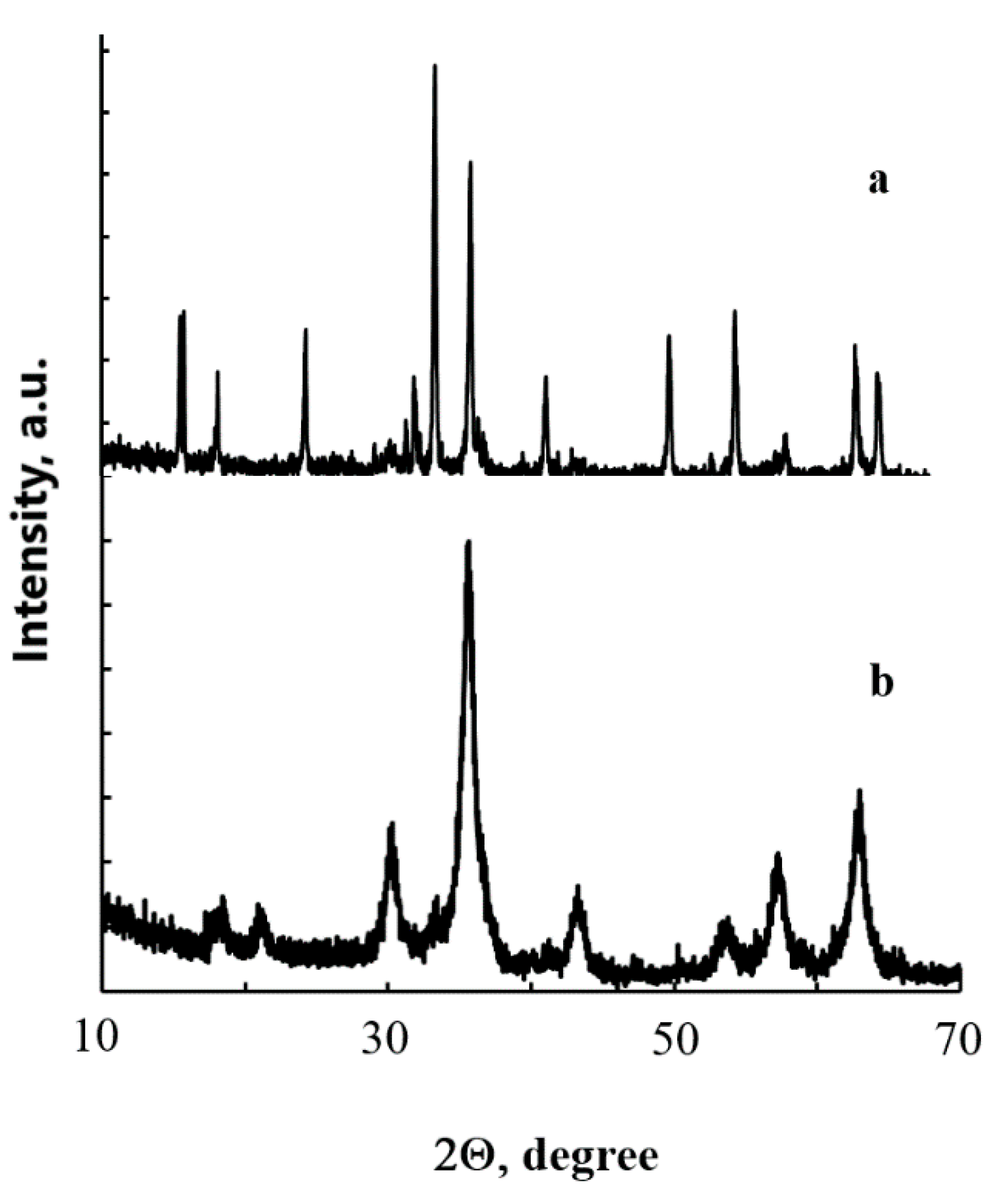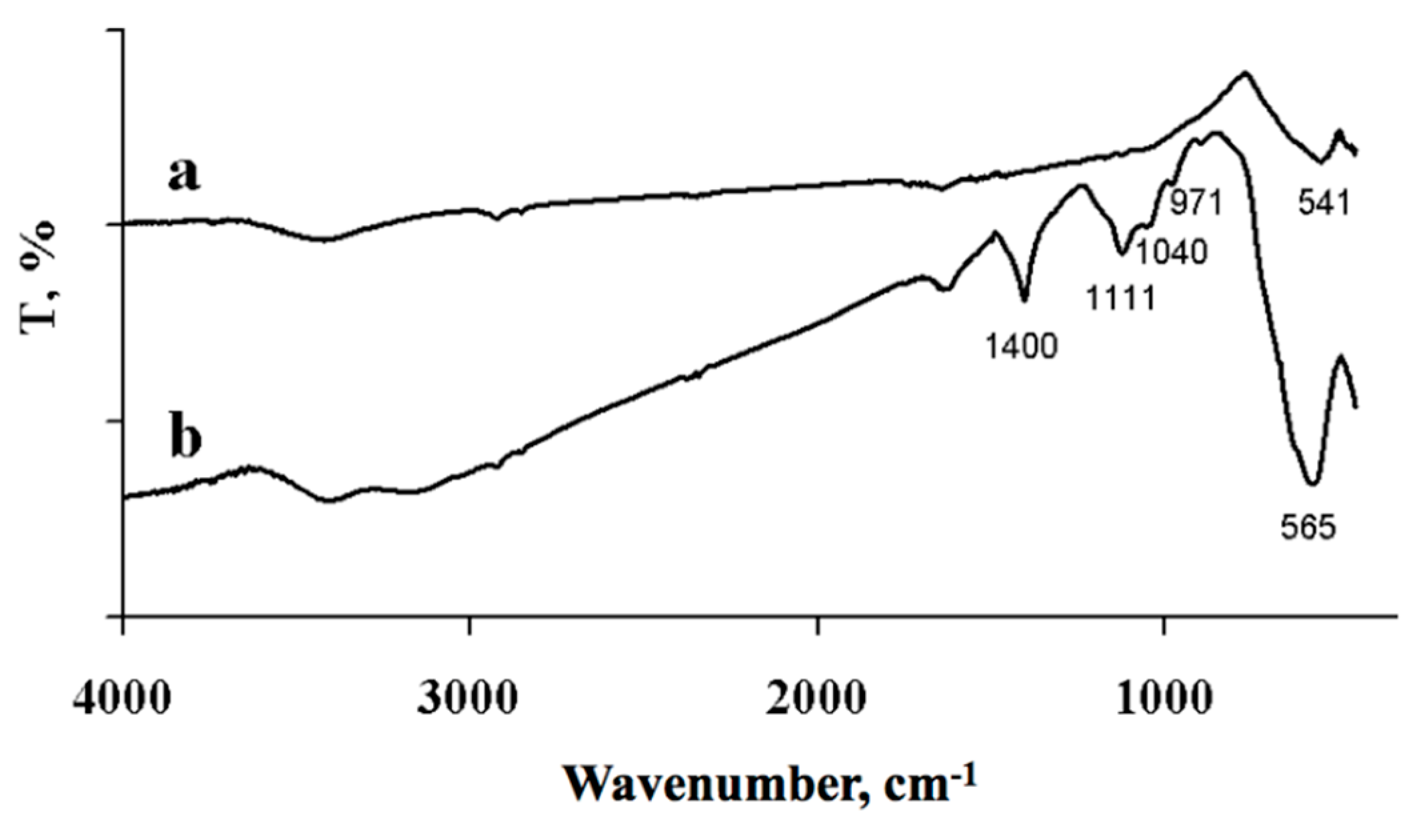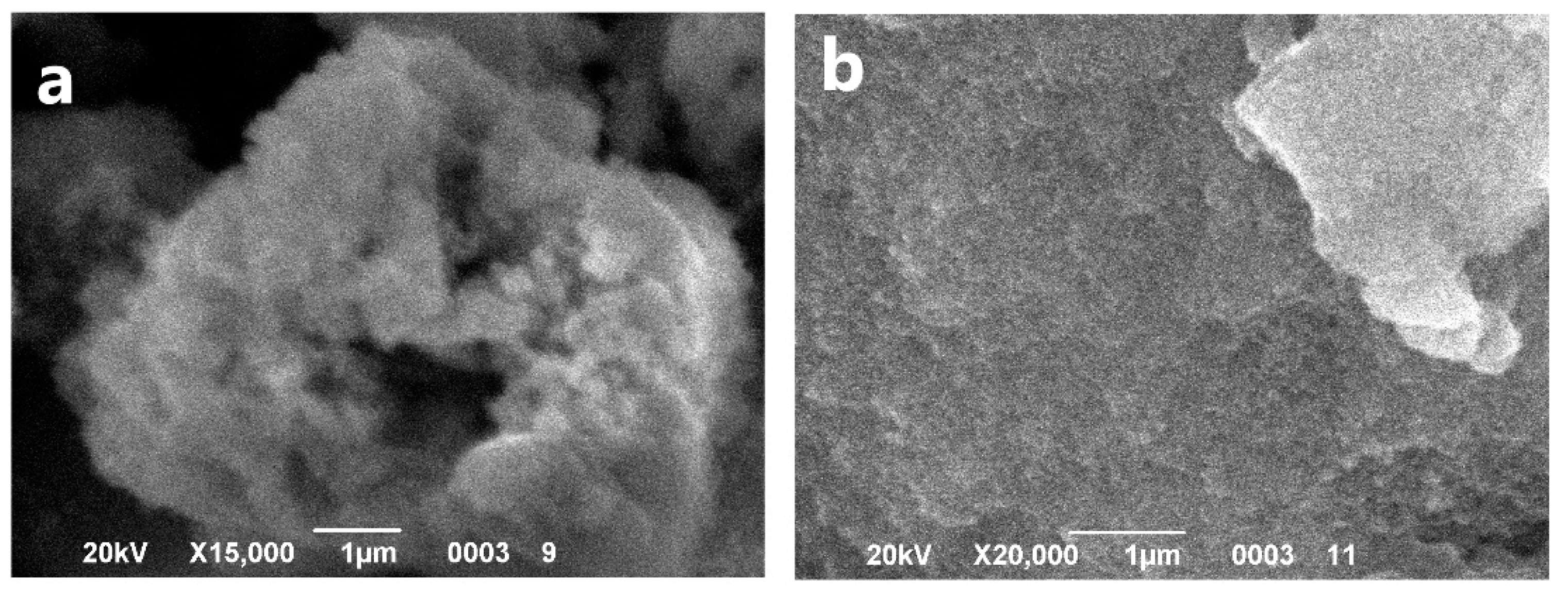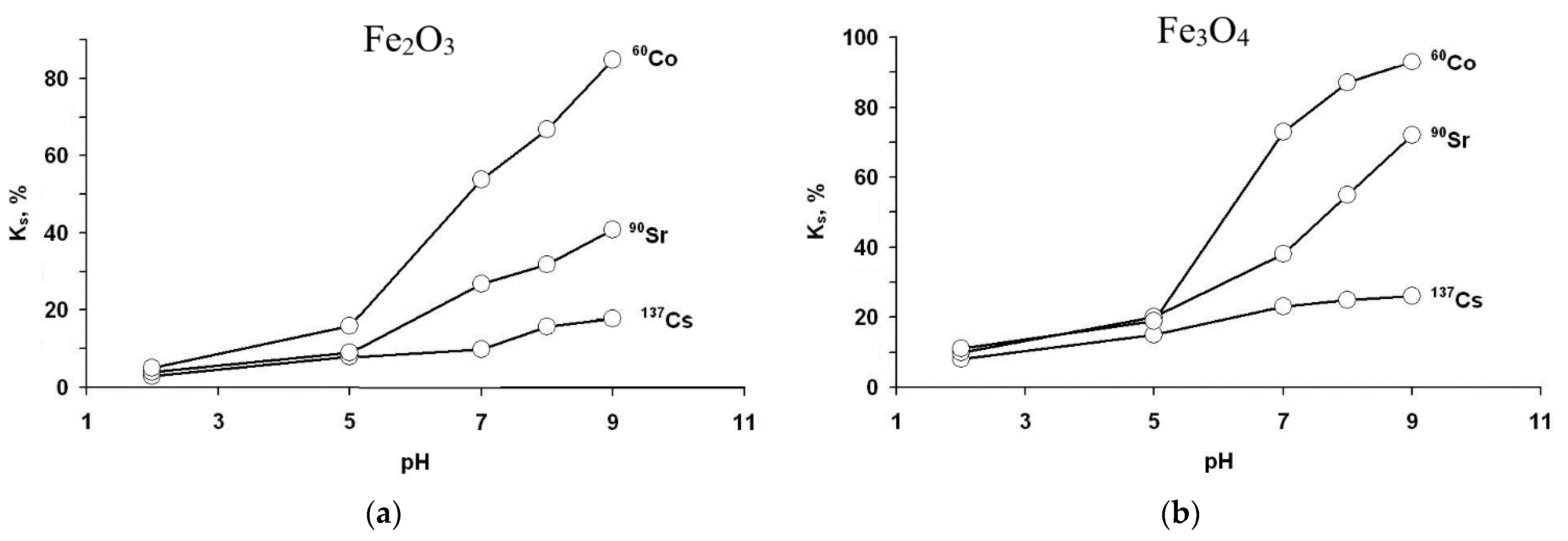Uptake of Radionuclides 60Co, 137Cs, and 90Sr with α-Fe2O3 and Fe3O4 Particles from Aqueous Environment
Abstract
:1. Introduction
2. Materials and Methods
2.1. Synthesis of Powders α-Fe2O3 and Fe3O4
2.2. Sorption Tests
2.3. Measurement Apparatus
3. Results and Discussion
3.1. Characteristics of the Sorbents
3.2. Effect of Sorption Time
3.3. Effect of pH
3.4. Drinking Water Treatment
4. Conclusions
Author Contributions
Funding
Institutional Review Board Statement
Informed Consent Statement
Data Availability Statement
Acknowledgments
Conflicts of Interest
References
- Tagami, K.; Uchida, S.; Shinano, T.; Pröhl, G. Comparisons of effective half-lives of radiocesium in Japanese tea plants after two nuclear accidents, Chernobyl and Fukushima. J. Environ. Radioact. 2020, 213, 106109. [Google Scholar] [CrossRef]
- Dragović, S.; Yamauchi, M.; Aoyama, M.; Kajino, M.; Petrović, J.; Ćujić, M.; Dragović, R.; Đorđević, M.; Bór, J. Synthesis of studies on significant atmospheric electrical effects of major nuclear accidents in Chernobyl and Fukushima. Sci. Total Environ. 2020, 733, 139271. [Google Scholar] [CrossRef] [PubMed]
- WHO. Guidelines for Drinking Water Quality: Recommendations; World Health Organization: Geneva, Switzerland, 2004. [Google Scholar]
- Sobotovich, E.V.; Bondarenko, G.N.; Olkhovik, Y.A. Radiochemistry in the Zone of Influence of the Chernobyl Nuclear Power Plant; Naukova Dumka: Kiev, Ukraine, 1992. (In Russian) [Google Scholar]
- Kazachonok, N.N.; Kostyuchenko, V.A.; Popova, I.Y.; Polyanchikova, G.V. Research into the Factors Affecting the Uptake of 90Sr and 137Cs by Plants from Radioactively Contaminated Soils of the Southern Urals. Health Phys. 2012, 103, 56–57. [Google Scholar] [CrossRef] [PubMed]
- Izrael, Y.A.; Sokolovsky, V.G.; Sokolov, V.E. Ecological consequences of radioactive pollution of natural environments in the area of the Chernobyl accident. At. Energy 1988, 64, 28–40. (In Russian) [Google Scholar] [CrossRef]
- Gupta, D.K.; Schulz, W.; Steinhauser, G.; Walther, C. Radiostrontium transport in plants and phytoremediation. Environ. Sci. Pollut. Res. 2018, 25, 29996–30008. [Google Scholar] [CrossRef]
- Rauwel, P.; Rauwel, E. Towards the Extraction of Radioactive Cesium-137 from Water via Graphene/CNT and Nanostructured Prussian Blue Hybrid Nanocomposites: A Review. Nanomaterials 2019, 9, 682. [Google Scholar] [CrossRef] [Green Version]
- Qiao, J.; Andersson, K.; Nielsen, S. A 40-year marine record of 137Cs and 99Tc transported into the Danish Straits: Significance for oceanic tracer studies. Chemosphere 2020, 244, 125595. [Google Scholar] [CrossRef] [Green Version]
- Kurikami, H.; Sakuma, K.; Malins, A.; Sasaki, Y.; Niizato, T. Numerical study of transport pathways of 137Cs from forests to freshwater fish living in mountain streams in Fukushima, Japan. J. Environ. Radioact. 2019, 208–209, 106005. [Google Scholar] [CrossRef] [PubMed]
- Ali, I.; Basheer, A.A.; Mbianda, X.Y.; Burakov, A.; Galunin, E.; Burakova, I.; Mkrtchyan, E.; Tkachev, A.; Grachev, V. Graphene based adsorbents for remediation of noxious pollutants from wastewater. Environ. Int. 2019, 127, 160–180. [Google Scholar] [CrossRef]
- Demir, M.; Konukoğlu, D.; Kabasakal, L.; Yelke, H.K.; Ergen, K.; Ahmed, S. The effects of exposure of 60Co on the oxidant/antioxidant status among radiation victims. J. Environ. Radioact. 2003, 64, 19–25. [Google Scholar] [CrossRef]
- Medyńska-Juraszek, A.; Ćwieląg-Piasecka, I.; Jerzykiewicz, M.; Trynda, J. Wheat Straw Biochar as a Specific Sorbent of Cobalt in Soil. Materials 2020, 13, 2462. [Google Scholar] [CrossRef]
- Flieger, J.; Kawka, J.; Płaziński, W.; Panek, R.; Madej, J. Sorption of Heavy Metal Ions of Chromium, Manganese, Selenium, Nickel, Cobalt, Iron from Aqueous Acidic Solutions in Batch and Dynamic Conditions on Natural and Synthetic Aluminosilicate Sorbents. Materials 2020, 13, 5271. [Google Scholar] [CrossRef]
- Krasnopyorova, A.P.; Yukhno, G.D.; Efimova, N.V. Sorption and extraction extraction of radionuclides from liquid media by natural and synthetic materials. In Complexation and Association in Solutions with the Participation of Metal-Containing Particles, Functional and Colored Substances: Practical Solutions and Developments; Shapovalova, S.A., Ed.; VN Karazin KhNU: Kharkiv, Ukraine, 2018; pp. 65–105. (In Ukrainian) [Google Scholar]
- Sofronov, D.; Krasnopyorova, A.; Efimova, N.; Oreshina, A.; Bryleva, E.; Yuhno, G.; Lavrynenko, S.; Rucki, M. Extraction of radionuclides of cerium, europium, cobalt and strontium with Mn3O4, MnO2, and MnOOH sorbents. Process Saf. Environ. Prot. 2019, 125, 157–163. [Google Scholar] [CrossRef]
- Milyutin, V.V.; Nekrasova, N.A.; Kharitonov, O.V.; Firsova, L.A.; Kozlitin, E.A. Sorption technologies in modern applied radiochemistry. Sorpt. Chromatogr. Process. 2016, 16, 313–322. (In Russian) [Google Scholar]
- Metwally, S.S.; Hassan, H.S.; Samy, N.M. Impact of environmental conditions on the sorption behavior of 60Co and 152+154Eu radionuclides onto polyaniline/zirconium aluminate composite. J. Mol. Liq. 2019, 287, 110941. [Google Scholar] [CrossRef]
- Mahmoud, M.E.; Allam, E.A.; El-Sharkawy, R.M.; Soliman, M.A.; Saad, E.A.; El-Khatib, A.M. Nano-manganese oxide-functionalized-oleyl amine as a simple and low cost nanosorbent for remediation of ZnII/CoII and their radioactive nuclides 65Zn and 60Co from water. Appl. Radiat. Isot. 2020, 159, 108989. [Google Scholar] [CrossRef] [PubMed]
- Mahmoud, M.E.; Allam, E.A.; Saad, E.A.; El-Khatib, A.M.; Soliman, M.A. Remediation of Co/Zn ions and their 60Co/65Zn radioactive nuclides from aqueous solutions by acid activated nanobentonite. Environ. Nanotechnol. Monit. Manag. 2019, 12, 100277. [Google Scholar] [CrossRef]
- Park, J.G.; Han, W.S.; Choung, S.; Hwang, J.; Kim, Y.T.; Yun, T.K. Evaluation of optimal size of illite adsorbent for 137Cs removal in contaminated artificial lake. J. Environ. Manag. 2020, 269, 110739. [Google Scholar] [CrossRef] [PubMed]
- Al Attar, L.; Safia, B.; Ghani, B.A. Uptake of 137Cs and 85Sr onto thermally treated forms of bentonite. J. Environ. Radioact. 2018, 193–194, 36–43. [Google Scholar] [CrossRef]
- Puzyrnaya, L.N.; Shunkov, V.S.; Pshinko, G.N.; Kosorukov, A.A.; Demchenko, V.Y. The use of magnetic potassium–zinc hexacyanoferrate(II) for sorption concentration of radionuclide cesium. J. Water Chem. Technol. 2017, 39, 73–79. [Google Scholar] [CrossRef]
- Singh, B.K.; Tomar, R.; Kumar, S.; Jain, A.; Tomar, B.S.; Manchanda, V.K. Sorption of 137Cs, 133Ba and 154Eu by synthesized sodium aluminosilicate (Na-AS). J. Hazard. Mater. 2010, 178, 771–776. [Google Scholar] [CrossRef] [PubMed]
- Voronina, A.V.; Noskova, A.Y.; Semenishchev, V.S.; Gupta, D.K. Decontamination of seawater from 137Cs and 90Sr radionuclides using inorganic sorbents. J. Environ. Radioact. 2020, 217, 106210. [Google Scholar] [CrossRef]
- Abdel-Galil, E.A.; Hassan, R.S.; Eid, M.A. Assessment of nano-sized stannic silicomolybdate for the removal of 137Cs, 90Sr, and 141Ce radionuclides from radioactive waste solutions. Appl. Radiat. Isot. 2019, 148, 91–101. [Google Scholar] [CrossRef]
- Sadeghi, M.; Yekta, S.; Ghaedi, H.; Babanezhad, E. MnO2 NPs-AgX zeolite composite as adsorbent for removal of strontium-90 (90Sr) from water samples: Kinetics and thermodynamic reactions study. Mater. Chem. Phys. 2017, 197, 113–122. [Google Scholar] [CrossRef]
- Zhang, J.; Chen, L.; Dai, X.; Zhu, L.; Xiao, C.; Xu, L.; Zhang, Z.; Alekseev, E.V.; Wang, Y.; Zhang, C.; et al. Distinctive Two-Step Intercalation of Sr2+ into a Coordination Polymer with Record High 90Sr Uptake Capabilities. Chem 2019, 5, 977–994. [Google Scholar] [CrossRef]
- Sobhanardakani, S.; Jafari, A.; Zandipak, R.; Meidanchi, A. Removal of heavy metal (Hg(II) and Cr(VI)) ions from aqueous solutions using Fe2O3@SiO2 thin films as a novel adsorbent. Process Saf. Environ. Prot. 2018, 120, 348–357. [Google Scholar] [CrossRef]
- Zhu, X.; Song, T.; Lv, Z.; Ji, G. High-efficiency and low-cost α-Fe2O3 nanoparticles-coated volcanic rock for Cd(II) removal from wastewater. Process Saf. Environ. Prot. 2016, 104 Pt A, 373–381. [Google Scholar] [CrossRef]
- Cornell, R.M.; Schwertmann, U. The Iron Oxides: Structure, Properties, Reactions, Occurrences and Uses, 2nd ed.; Wiley-VCH: Weinheim, Germany, 2003. [Google Scholar]
- Odnovolova, A.M.; Sofronov, D.S.; Puzan, A.N.; Baumer, V.N.; Mateychenko, P.V.; Desenko, S.M.; Vovk, O.M.; Mozul’, K.A.; Bryleva, E.Y. Formation characteristics of Fe3O4 magnetic particles precipitated from aqueous solutions and their sorption properties. Funct. Mater. 2015, 22, 475–481. [Google Scholar] [CrossRef]
- Lubentsova, K.I.; Pastukhov, A.V.; Davankov, V.A.; Kitaeva, D.K.; Karandi, I.V.; Ilyin, M.M. Sorption of toxic organic and inorganic compounds by composites with nanodispersed iron oxides in polystyrene sorbent matrices. Sorpt. Chromatogr. Process. 2015, 15, 333–344. (In Russian) [Google Scholar]
- Odnovolova, A.M.; Sofronov, D.S.; Bryleva, E.Y. Removal cobalt, europium, cerium, strontium and copper by Fe2O3 and Fe3O4 particles from aqueous solutions. Sorpt. Chromatogr. Process. 2015, 15, 523–531. (In Russian) [Google Scholar]
- Sofronov, D.S.; Belikov, K.N.; Rucki, M.; Lavrynenko, S.N.; Siemiątkowski, Z.; Bryleva, E.Y.; Odnovolova, O.M. Synthetic Sorbent Materials Based on Metal Sulphides and Oxides; Taylor & Francis: New York, NY, USA, 2021. [Google Scholar] [CrossRef]
- Krasnopyorova, A.; Yuhno, G.; Lebedeva, L. The Sorption of Long-living Radionuclides 90Sr and 137Cs by Natural Polysaccharides. Pol. J. Chem. 2008, 82, 419–424. [Google Scholar]
- Jolstera, R.; Gunneriusson, L.; Holmgren, A. Surface complexation modeling of Fe3O4–H+ and magnesium (II) sorption onto maghemite and magnetite. J. Colloid. Interf. Sci. 2012, 386, 260–267. [Google Scholar] [CrossRef] [PubMed]
- Sofronov, D.S.; Kamneva, N.N.; Bulgakova, A.V.; Mateychenko, P.V.; Baumer, V.N.; Belikov, K.N.; Chebanov, V.A.; Lavrynenko, S.N.; Mamalis, A.G. Effect of anions and medium pH on the formation of ZnS micro- and nanoparticles from thiourea solutions. J. Biol. Phys. Chem. 2013, 13, 85–89. [Google Scholar] [CrossRef]
- Hong, R.Y.; Pan, T.T.; Li, H.Z. Microwave synthesis of magnetic Fe3O4 nanoparticles used as a precursor of nanocomposites and ferrofluids. J. Magn. Magn. Mater. 2006, 303, 60–68. [Google Scholar] [CrossRef]
- Wells, A. Structural Inorganic Chemistry; Oxford University Press: Oxford, UK, 2012. [Google Scholar]
- Egorin, A.; Tokar, E.; Kalashnikova, A.; Sokolnitskaya, T.; Tkachenko, I.; Matskevich, A.; Filatov, E.; Zemskova, L. Synthesis and Sorption Properties towards Sr-90 of Composite Sorbents Based on Magnetite and Hematite. Materials 2020, 13, 1189. [Google Scholar] [CrossRef] [Green Version]
- Michel, M.M.; Reczek, L.; Papciak, D.; Włodarczyk-Makuła, M.; Siwiec, T.; Trach, Y. Mineral Materials Coated with and Consisting of MnOx—Characteristics and Application of Filter Media for Groundwater Treatment: A Review. Materials 2020, 13, 2232. [Google Scholar] [CrossRef] [PubMed]
- Gdula, K.; Gładysz-Płaska, A.; Cristóvão, B.; Ferenc, W.; Skwarek, E. Amine-functionalized magnetite-silica nanoparticles as effective adsorbent for removal of uranium(VI) ions. J. Mol. Liq. 2019, 290, 111217. [Google Scholar] [CrossRef]





| Sorbent | Sorption Coefficients toward Respective Radionuclide Ks, % | ||
|---|---|---|---|
| 137Cs | 90Sr | 60Co | |
| α-Fe2O3 | 8.7% | 19.8% | 51.4% |
| Fe3O4 | 18.7% | 34.8% | 71.6% |
| Indicators | Content before and after Treatment, mg/dm3 | ||
|---|---|---|---|
| Before | After α-Fe2O3 | After Fe3O4 | |
| Sodium (Na+) | 93.0 | 92.7 | 92.5 |
| Potassium (K+) | 13.0 | 12.3 | 12.0 |
| Magnesium (Mg2+) | 24.3 | 14.2 | 13.9 |
| Calcium (Ca2+) | 86.2 | 27.6 | 27.1 |
| Sulfates (SO42−) | 107.5 | 104.9 | 104.5 |
| Hydrogen carbonates (HCO3−) | 293.0 | 157.1 | 147.0 |
| Chlorides (Cl−) | 160.0 | 156.0 | 156.0 |
Publisher’s Note: MDPI stays neutral with regard to jurisdictional claims in published maps and institutional affiliations. |
© 2021 by the authors. Licensee MDPI, Basel, Switzerland. This article is an open access article distributed under the terms and conditions of the Creative Commons Attribution (CC BY) license (https://creativecommons.org/licenses/by/4.0/).
Share and Cite
Efimova, N.V.; Krasnopyorova, A.P.; Yuhno, G.D.; Sofronov, D.S.; Rucki, M. Uptake of Radionuclides 60Co, 137Cs, and 90Sr with α-Fe2O3 and Fe3O4 Particles from Aqueous Environment. Materials 2021, 14, 2899. https://doi.org/10.3390/ma14112899
Efimova NV, Krasnopyorova AP, Yuhno GD, Sofronov DS, Rucki M. Uptake of Radionuclides 60Co, 137Cs, and 90Sr with α-Fe2O3 and Fe3O4 Particles from Aqueous Environment. Materials. 2021; 14(11):2899. https://doi.org/10.3390/ma14112899
Chicago/Turabian StyleEfimova, Natalya V., Alla P. Krasnopyorova, Galina D. Yuhno, Dmitry S. Sofronov, and Mirosław Rucki. 2021. "Uptake of Radionuclides 60Co, 137Cs, and 90Sr with α-Fe2O3 and Fe3O4 Particles from Aqueous Environment" Materials 14, no. 11: 2899. https://doi.org/10.3390/ma14112899







